Sentra takes Nissan out of the park for 2013
By John Gilbert
SAN FRANCISCO, CALIF. — In Nissan’s ever-expanding universe of cars and trucks, the compact Sentra has been relegated to something akin to a support role. Sort of like a durable and dependable infielder or utility player who is both vital to success and easily overlooked while the stars hit home runs and make the big headlines.
World Series time in 2012, however, is the perfect time to find out how invaluable such performers are in clutch situations. The San Francisco Giants were winning their way to a World Series date with the Detroit Tigers when Nissan just happened to summon auto media types to San Francisco for the introduction of both the 2013 Sentra and Pathfinder, which could be game-breakers in far-reaching segments. We’ll deal with the Pathfinder at another time, but for now let’s focus on the Sentra, to coin a phrase.
The Sentra has ranged from drab to nondescript throughout its steady sales lifespan, suddenly emerges as a stylish and feature-filled compact, with neat lines, abundant features, and fuel economy that is exceptional enough to challenge segment front-runners such as Civic, Elantra, Focus, Mazda3, Corolla and Cruze.
We drove the Sentra models around San Francisco, then across the Golden Gate bridge and up to Napa Valley, where we made the transition the following day to be immersed into the Pathfinder lifestyle for an intense though brief examination of both vehicles. We’ll deal with the Pathfinder in due time, but for now, let’s examine the Sentra.
Without suggesting the Sentra has been confined to benchwarmer status through its first six generations, there is no doubt the unveiling of the seventh generation Sentra for 2013 is stepping up to the plate with aspirations to deliver a rally-extending hit for Nissan. It starts out with styling, which borrows a bit from the bold designing touches of the just-introduced midsize Altima for a contemporary and decidedly upscale appearance.
Go back through its history, and Generation 1 (1982-86), 2 (’86-90), 3 (’91-94), 4 (’95-99), 5 (2000-06) all were sturdy and efficient but had styling that wasn’t what you’d write home about. Generation 6, which came out for 2007, finally indicated that Nissan designers realized they might round third and head for home with some edgier looks. Still, it was eclipsed by a Civic that delivered a Car-of-the-Year Grand Slam, while Mazda3 also was a big hit. Hyundai’s Elantra, the 2012 North American Car of the Year, intensified the segment’s competition with a great package, and an all-new global Focus and Cruze have heightened awareness of the compact segment this year.
So the new Sentra has to fight for everyday playing time or be rendered to the minor leagues of consumer awareness, and the 2013 raises the potential of a nameplate that has sold over 4.3 million cars over the past 30 years, with all generations made in the U.S. To meet basic requirements of the new-age compact segment, the Sentra offers fuel economy that can easily eclipse the EPA estimates of 30 mpg city and 39 highway for a 34-miles-per-gallon combined average, and offers its new styling and interior at prices that range from a base of $15,990 to $20,000 for five different models.
John Curl, the senior marketing manager of Nissan’s product planning, says the new car has “class-above technology,” to live up to an exterior that cuts a profile much more sharply defined and stylish than any of its soap-carving predecessors. A character line carved into its sides amplify its lower and more forward-leaning stance, and obviously revised proportions.
Front headroom and legroom measure the biggest among compacts, and extending the rear overhang allows a 15.1 cubic foot trunk capacity (2 cubic feet larger than 2012), plus rear-seat legroom that is more than an inch more than any competitor, at 37.4 inches. The whole package is enclosed by a body built with more high-strength steel, for a stronger structure that is also 150 pounds lighter.
The exterior is set off with a front end that features a grille that shows a family resemblance to the flashy new Altima, and has new headlight enclosures underlined by the sort of LED accents that have become so important to larger and more luxurious cars. The taillights are extra-bright LEDs too, and enclose a body that has computer-aided design aerodynamics of 0.29 coefficient of drag. There is a sportier SR model that offers revised front and rear fascias, lower side sills, rear spoiler, larger 17-inch alloy wheels, fog lights, and brushed silver interior trim.
Interior features more than live up to the promise of the new exterior, which should be a major attraction to compact customers who may not understand, or care to understand, the improvements in engine technology and performance. The engine is a 1.8-liter 4-cylinder, which is not new by dimension overview, but it is an all-new engine, with a longer stroke and twin continuously-variable valve timing on both intake and exhaust camshafts and beehive-shaped valve springs that have a smaller diameter at the top to reduce inertia weight and improve engine response. The longer stroke improves low-end torque, and the engine produces 130 horsepower at 6,000 RPMs, wit 128 foot-pounds of torque at 3,600 revs.
Nissan resisted the move other manufacturers have made to abandon the technology of continuously-variable transmissions, because initial reaction was uneasiness from the lack of easy to feel traditional steps of gear changes in their automatics, because CVTs have a continuous belt that activates two pulleys, shifting continuously as one pulley enlarges. Most CVTs tend to drone without any change in sound, even though shifting always puts the car in optimum gear range. By sticking to their devotion to CVTs, Nissan now makes arguably the most efficient one, and uses it in all cars with automatics.
The advanced second-generation CVT in the Sentra is more compact and activates an auxiliary gearbox with planetary gearing to gain a transmission ratio of 7.3-to-1, a broader span than other CVTs, and even wider than a typical 7-speed automatic. The wider ratio puts the Sentra in a better range for low-end takeoff, and also a better range for highway cruising. In addition, the driver can select Eco or Sport modes as alternatives to the Normal setting to change throttle response and transmission tuning.
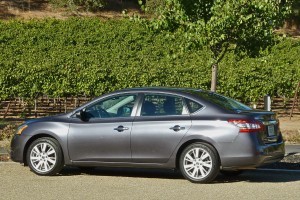
The new Sentra's silhouette is the greatest departure from the sturdy but stodgy designs of previouis Sentras.
By models, the Sentra starts with the S, at $15,990, with either a 6-speed stick or the CVT but with most of the new style features; the SV starts at $17,970 with the CVT and upgraded audio and steering wheel controls among added features; the SR is the sport model and starts at $18,870 with CVT darker grille, unique fascias and larger alloy wheels; the SL starts at $19,760 with the CVT and all the SV features plus dual zone air-conditioning, wood tone interior trim and smart-key operation; and the FE+ can be added to either the S or SV to enhance fuel-efficiency with a unique rear spoiler, underbody aero panels and low rolling-resistance tires.
A navigation package adds $650. Despite the restyling, new engine and CVT, and all the new features, chief marketing manager Fred dePerez said model for model, the Sentra is actually $440 less than the current model. The SR is $500 more, but a sporty model wasn’t previously offered since the beloved SE-R of the third generation, and its price is far less than its added content.
A point of interest is that only the most basic S Grade is available with standard transmission — as a “no-cost” option. John Curl said that it was because Nissan’s market research and recent marketing had shown there was a “low take-rate” on stick shifts. That led me to ask if it wasn’t a self-fulfilling prophecy, because while some competitors have indicated higher take-rates, and are expanding manual transmission availability, offering a stick on only the most basic Sentra means the take-rate will be even more reduced on the new array of Sentras. It reminded me of when Chevrolet justified a switch to all automatics with a Malibu of a couple of generations ago because of low take-rate, causing me to suggest that if no stick is available, a zero-percent take rate was pretty much assured.
The stick shift is a 6-speed, while some competitors still offer only 5-speeds, and it is a smooth unit that would logically attract buyers who might want a sportier performing compact, while also wanting the expanded amenities Sentra offers on its upgraded levels.
My driving partner on this occasion was a fellow named Wayne Gerdes, who is a hyper-mileage specialist from Illinois, and who convinced me that it’s possible to alter your driving style to reach astronomical fuel economy numbers — something that always has been important to me, even though the sheer pleasure of running up the revs as you run through the gears might be a better evaluation of outright performance, and fun. We made a good combination, because while Gerdes wants to upshift as early as possible, which requires a manual, and coast down hills, and up to stoplights hoping to maintain momentum as the light changes, I like to add some higher-rev pushing around tight turns, although I found it enjoyable to also adopt some of his tricks.
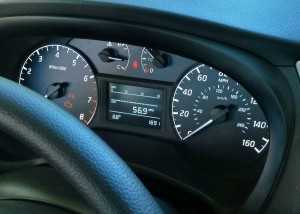
Our test-drive fuel economy was startling in the 2013 Sentra, including a peak displayed at 56.9 mpg.
We first drove an SL model, and found the CVT quite properly responsive. We appreciated the widened gear range, but I found a switch on the shift lever that effectively drops the gear range, sort of like what downshifting from sixth to fifth might be, and I tried it on a few hilly curves. Over nearly 100 miles, I attained 33.3 miles per gallon. My co-driver, meanwhile, didn’t bother with the switch with his unique driving method, and got a remarkable 46.3 mpg.
Later, we switched to the S model, with the 6-speed stick, and not only found it more enjoyable. I drove quite normally, but I didn’t run the revs up as much as I normally would, and achieved 46.3 miles per gallon, which I thought was exceptional, based on the EPA estimated maximum of 39. My partner astounded me, however, by recording 56.9 miles per gallon on his turn. That made him more frustrated that only one of the five Sentra models is available with a manual transmission. His driving technique and astronomical mileage figures might induce a lot of customers to foul up Nissan’s take-rate projections.
Without a doubt, the interior amenities will enhance the Sentra’s popularity. Curl pointed out that the soft-touch padding everywhere is part of his idea of class-above technology, with everything from the dashboard to door panels, armrests, and instrument panel being soft to the touch. Electronics and connectivity are major elements of contemporary cars, and Sentra offers virtually all of them. You can choose models with upgraded cloth or leather seats; an audio upgrade up to an 8-speaker Bose system; Google navigation that includes weather, points of interest, warnings for curves and speed zones; hands-free text messaging, which displays messages on the screen and reads them aloud to you to avoid distractions from driving.
Also available is the unique feature introduced on the Altima of a tire-inflation device which not only indicates low air pressure, but beeps when you’ve filled it to the proper pressure, virtually making obsolete the tire pressure gauges that you never seem to have with you and are impossible to borrow from most convenience-store/fuel stations.
Marketing manager dePerez said, “This segment used to be price, price, price, and buyers didn’t mind hard plastic and low-rent features. But now customers want their smaller cars to have more room, more fuel economy, more power, and more features.”
The seventh-generation Sentra has rounded third and is heading for home on all of Nissan’s objectives for a high-tech, “class-above” compact sedan. But even with five models, there’s room for revisiting an SE-R model someday, with all the top-line sporty features — and a 6-speed stick.
Comments
Tell me what you're thinking...
and oh, if you want a pic to show with your comment, go get a gravatar!


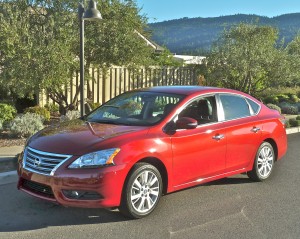
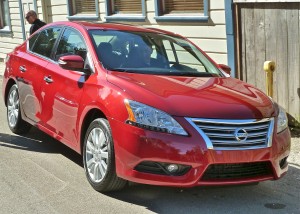
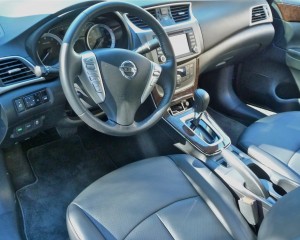
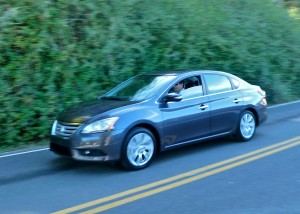
 John Gilbert is a lifetime Minnesotan and career journalist, specializing in cars and sports during and since spending 30 years at the Minneapolis Tribune, now the Star Tribune. More recently, he has continued translating the high-tech world of autos and sharing his passionate insights as a freelance writer/photographer/broadcaster. A member of the prestigious North American Car and Truck of the Year jury since 1993. John can be heard Monday-Friday from 9-11am on 610 KDAL(www.kdal610.com) on the "John Gilbert Show," and writes a column in the Duluth Reader.
John Gilbert is a lifetime Minnesotan and career journalist, specializing in cars and sports during and since spending 30 years at the Minneapolis Tribune, now the Star Tribune. More recently, he has continued translating the high-tech world of autos and sharing his passionate insights as a freelance writer/photographer/broadcaster. A member of the prestigious North American Car and Truck of the Year jury since 1993. John can be heard Monday-Friday from 9-11am on 610 KDAL(www.kdal610.com) on the "John Gilbert Show," and writes a column in the Duluth Reader.